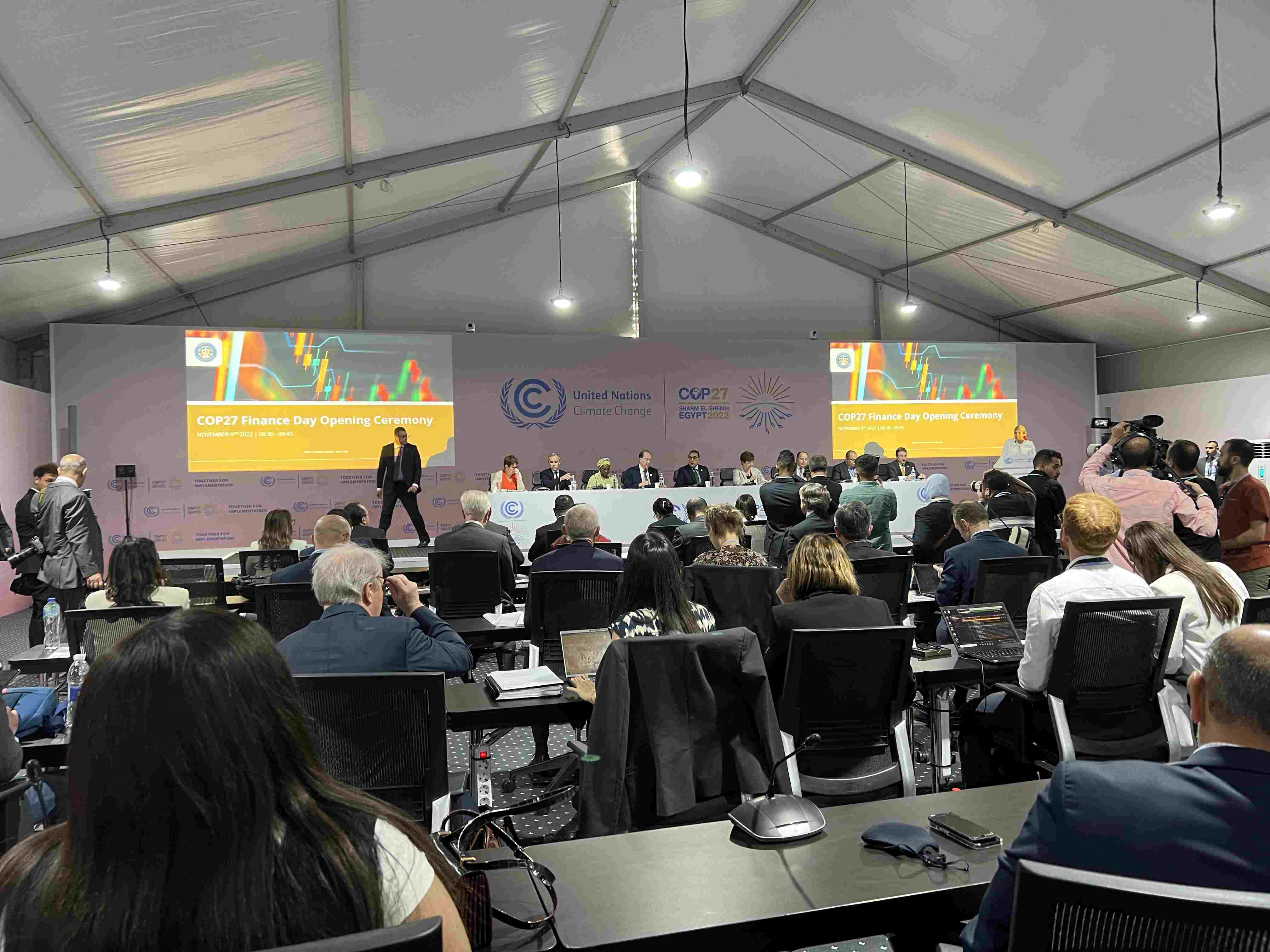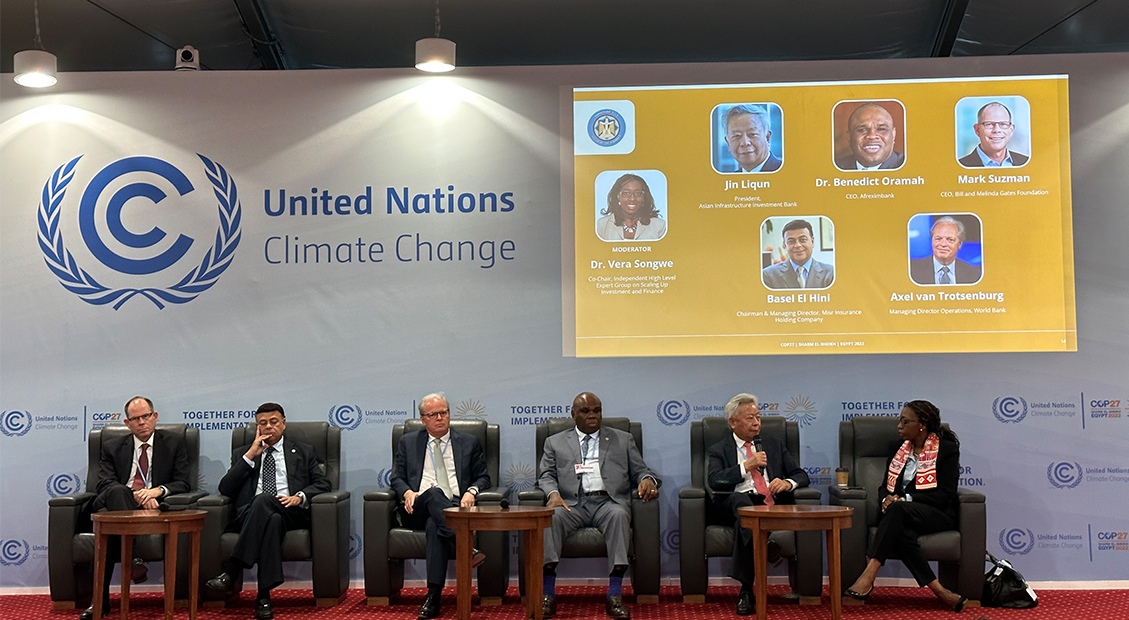The fast pace of the Asian Infrastructure Investment Bank’s (AIIB) engagement with various stakeholders continued on-ground at COP27. At the higher, strategic level among leaders of governments and institutions, there was a spotlight on multilateral development banks (MDBs) and on overhauling the financial system at the Egyptian Presidency thematic sessions. From the AIIB side, we advanced our focus on our three messages and commenced initiatives and signings related to this. At the same time, the climate negotiators worked late into the night to address contentious issues such as increasing ambition, adaptation and resilience, loss and damage and the mechanics of the carbon markets.
The perennial strategic question continues on how to mobilize and disburse the trillions of dollars needed to avert catastrophic climate change, adapt and build resilience in the context of limited fiscal space. There is no one easy answer, and different solutions have been brought forward.
Prime Minister of Barbados Bridgetown initiative
Among the most significant solutions mentioned is Mia Mottley Prime Minister of Barbados’s Bridgetown initiative that tries to address the “trillion-dollar” and “limited fiscal space” questions. The initiative focuses on the following points as per E3G reporting.
- Developed countries can exercise influence to push the World Bank and other MDBs to better leverage their balance sheets. Recommendations from a G20 expert group could leverage an additional USD1 trillion for climate and development finance. COP should build acceptance that these recommendations must be implemented.
- US and European leaders can deliver promises of emergency liquidity using USD100 billion of Special Drawing Rights, through the International Monetary Fund (IMF) and MDBs creating fiscal space in developing countries, quickly and without harmful conditions.
- Creating a Loss and Damage funding mechanism will support climate equity at COP. Political support for the UNSG proposal to tax windfall profits from oil and gas exports could be an important first step. At COP, a group of countries could lead a feasibility study on this proposal.
- Innovative funding mechanisms could unlock additional political capital for a paradigm shift in resource mobilization. A Global Climate Mitigation Trust, borrowing on capital markets, backed by USD500 billion of Special Drawing Rights, donor guarantees, or similar instruments is another proposal. Hosted by the IMF or private sector arms of regional development banks, it would invest borrowed funds based on the size and pace of climate change mitigated, with potential to leverage private finance.
- Heightened recognition of the nexus of climate and development stimulates new ways to engage the private sector. Innovative instruments (debt for equity swaps, state contingent debt instruments, regional guarantee platforms) provide financing options for recipient countries, including the use of instruments that incentivize private finance and could stimulate increased South-South investments.
Finance leader solutions; The solution is doable
 Opening of the Egyptian Presidency Finance Day on Nov. 9, 2022.
Opening of the Egyptian Presidency Finance Day on Nov. 9, 2022.
The head of the IMF and other finance leaders recognize that we are in a situation of multiple crises, which is a different situation from COP26. However, the climate challenge is not expensive to address, representing only 1 percent of global GDP.
Nicholas Stern, co-chair of the Independent High-Level Expert Group on Climate Finance, spoke of the need for a tripling of MDB financing capacity, helping with concessional loans to leverage/crowd in private sector capital and this costing very little vis-à-vis global GDP. This is a reflection on his new publication with Vera Songwe on Finance for climate action: scaling up investment for climate and development released during COP27. The report summarizes that USD 1 trillion of external finance per year (excluding China) is needed by 2030. Discussions on mobilizing and engaging domestic capital also ensued.
Fiscal space and debt issues can be addressed with debt service initiatives such as the debt reduction mechanisms/swaps proceeds for nature and climate. This has worked in a few countries in the Caribbean, including Belize. The Capital Adequacy Framework review is crucial in capital mobilization and temporary callable capital considered important.
Pricing carbon is key
Pricing carbon appropriately would be the most effective way of channeling capital to projects in developing countries. The price is currently USD5 per tonne of CO2. The price needs to increase up to USD75/80 at least by 2030, to be meaningful.
New finance structures needed
It was emphasized that finance is an enabler. Mark Carney, head of the Glasgow Financial Alliance for Net Zero (GFANZ), once again underscored that we have a short-term focus on efficiency and undervalue resilience of future resources. His emphasis being that the solution lies in mobilizing private sector finance. His focus is on ambition, action and accountability.
Other strategic points on financing structures are the following:
- There is a need to embed the lower cost of climate action, and it is about the transition.
- The public, private and NGO sectors need to work together and we need to have a derisking approach for long-term predictability. Local domestic capital needs to be mobilized as well.
- Climate mitigation and adaptation including nature-based solutions must be integrated in countries. Loss and damage need to be addressed as well, but with a different form of financing.
- Capital market mobilization via green and blue bonds and resilience bonds in developing countries is key. Standardization and quality of data is central to mobilize further capital. Uruguay has issued a remarkable sovereign bond linked to climate targets—USD1.5 billion oversubscribed—interest varied by performance.
- The launch of a carbon credit market for Africa was mentioned a few times.
- Mark Carney referred to a report on ESG dealing with greenwashing carried out by the UN and that companies cannot say they are net-zero when they are investing in fossil fuels.
- Operationally, NGOs/CSOs raised issues with transparency on Paris alignment and issues on how our methodologies will be applied to financial intermediaries.


